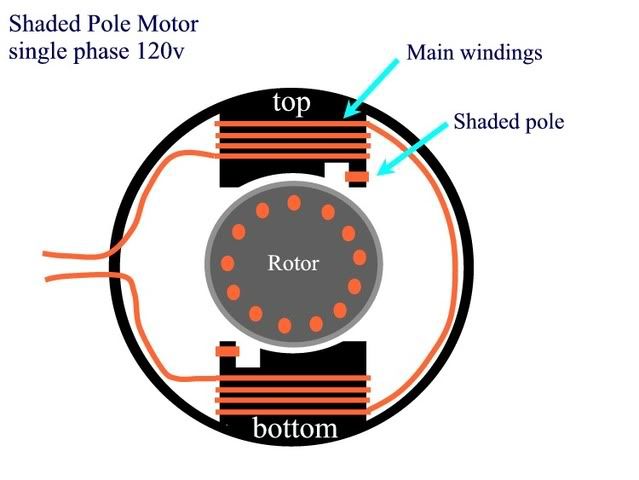First, for most single phase induction motors to be "self-starting" (to know which way to turn), we must somehow "split" the current into two out-of-phase currents. There are several ways to do this.
I'll start by discussing the "Shaded Pole" motor. The shaded pole motor consists of two "main winding poles" on the stator (It is possible to have more poles, but I'll stick with the simplest case of just two poles). Each of the main poles has a slot cut in it, and a piece of conductor is wound on the slot as shown in the drawing. This piece of copper is generally a single loop. If you will notice, essentially we have created a transformer with the main winding being the primary and the loop being the secondary. The loop is called a "shaded pole".
Looking at the main windings, and since this is single phase, as the sine wave changes positive and negative, the magnetic field simply swaps from north at top, south at bottom, to south at top and north at bottom. This magnetic field has no rotation, it just swaps back and forth, and the rotor has no idea which way it should turn.
For the motor to start, we must have a "rotating" magnetic field. This is where the shaded pole comes in. Since the shaded pole receives its current through induction, and since the shaded pole loop has different resistnace and reactance than the main windings, the current in the shaded pole will be out of phase with the current in the main windings.
Here is a diagram of the two currents:
Say we turn the motor on and say we are at the positive peak of the main winding sine wave (black). Let's say this creates a north pole at the top of the motor. The strongest magnetic field is going to be impressed from the main pole north at top to the main pole south at bottom, essentially the flux lines are vertical. But as time passes, the main pole current becomes weaker, and at some point the shaded pole current becomes stronger than the main pole = the shaded pole magnetic flux is stronger than the main pole magnetic flux. This would occur around the place where the "S" of the word "shaded" is in the diagram above.
Note that when the main pole current is zero, there is current in the shaded pole. So, the main pole magnetic field dies off and there is no longer a north at the very top of the motor. But the shaded pole current is still there.... and now the north magnetic field exists at the shaded pole. Essentially, the north pole has "rotated" from the exact top of the motor to a bit right of top. The magnetic field "rotates". And this is how a shaded pole motor starts.
The rotor will always turn toward the shaded pole. And, it is impossible to reverse a shaded pole motor - except they do make reversible ones which actually have a shaded pole on each side of each main pole and the shaded pole loops are actually made or broken through a switch, basically we choose which shaded poles to use.
Well, that is my view of the shaded pole motor. It certainly isn't gospel, and I welcome any comments.
Maybe we can tackle the "split-phase" motor soon?




